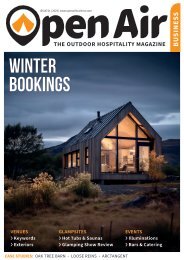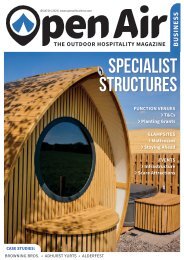Open Air Business February 2017
The UK's outdoor hospitality business magazine for function venues, glamping businesses and outdoor event organisers
The UK's outdoor hospitality business magazine for function venues, glamping businesses and outdoor event organisers
Create successful ePaper yourself
Turn your PDF publications into a flip-book with our unique Google optimized e-Paper software.
INDUSTRY TALK<br />
GETTY IMAGES<br />
consultant to understand whether<br />
planning permission will be<br />
required, or if your development<br />
falls within your permitted<br />
development rights.<br />
PERMITTED DEVELOPMENT<br />
RIGHTS<br />
In the 2013 Budget Statement,<br />
the Government realised that the<br />
Use Classes Order 1987 2 and the<br />
General Permitted Development<br />
Order 1995 3 were significant<br />
deregulatory tools that could<br />
be expanded to allow greater<br />
flexibility to the change between<br />
land uses that have similar<br />
impacts, without the need to<br />
apply for planning permission.<br />
Since this time, there have been<br />
a raft of changes to permitted<br />
development rights which allow<br />
further flexibility between use<br />
classes to support change of use<br />
from agricultural to certain other<br />
uses such as business, retail and<br />
residential. These changes are<br />
now in place, and are outlined<br />
within the consolidated Town<br />
and Country Planning (General<br />
Permitted Development) (England)<br />
Order 2015 (GPDO) (as amended).<br />
These changes have gone through<br />
a period of testing through various<br />
prior approvals and appeals, so<br />
there is now more certainty to<br />
what is required and, therefore,<br />
<strong>2017</strong> is the right time to try and<br />
make the most of your new<br />
business venture.<br />
The reason why it is important<br />
to distinguish whether your<br />
development falls within your<br />
permitted development rights is<br />
down to time and money. Utilising<br />
your permitted development<br />
rights should involve less work<br />
and time so that you can start your<br />
new venture without delay. This is<br />
because permitted development<br />
rights are essentially a national<br />
grant of planning permission,<br />
which allow certain building<br />
works and changes of use to be<br />
carried out without having to<br />
make a planning application.<br />
But, be aware that any permitted<br />
development rights are subject<br />
to conditions and limitations<br />
to control the impact of your<br />
development on the surrounding<br />
area and to protect local amenity.<br />
Schedule 2 of the GPDO 2015<br />
contains 19 parts relating to<br />
the different types of permitted<br />
development rights, but ‘Part<br />
3: Changes of Use’ and ‘Part 4:<br />
Temporary Buildings and Uses’ will<br />
be of most relevance to your new<br />
venture.<br />
CHANGE OF USE OF<br />
EXISTING BUILDINGS<br />
It may be beneficial to change<br />
existing agricultural buildings to<br />
support your open-air business i.e.<br />
function rooms for weddings.<br />
Class R of Part 4 of the 2015<br />
GPDO permits agricultural<br />
buildings and land in their<br />
curtilage to be converted to<br />
a “flexible commercial use”<br />
subject to a number of conditions<br />
and restrictions. A flexible use<br />
includes shops, financial and<br />
professional services, restaurants<br />
and cafes, business use, storage<br />
or distribution, hotels or assembly<br />
and leisure. In this respect, a<br />
function room could fall under<br />
2<br />
The Town and<br />
Country Planning<br />
(Use Classes) Order<br />
1987 (as amended)<br />
3<br />
The Town and<br />
Country Planning<br />
(General Permitted<br />
Development) Order<br />
1995 (as amended)<br />
the ‘assembly and leisure’ use<br />
permitted subject to adhering<br />
to the necessary condition and<br />
restrictions.<br />
Class R is only applicable to<br />
buildings that have been solely in<br />
agricultural use on 3 July, 2012,<br />
or if it was not in use on that date<br />
when it was last in use if now<br />
redundant. If the building was<br />
brought into agricultural use after<br />
3 July, 2012, then you will not be<br />
able to convert the building into a<br />
use defined in Class R for at least<br />
10 years.<br />
The rights under Class R do<br />
not extend to buildings that are<br />
listed or a scheduled monument;<br />
10 WWW.OPENAIRBUSINESS.COM


















